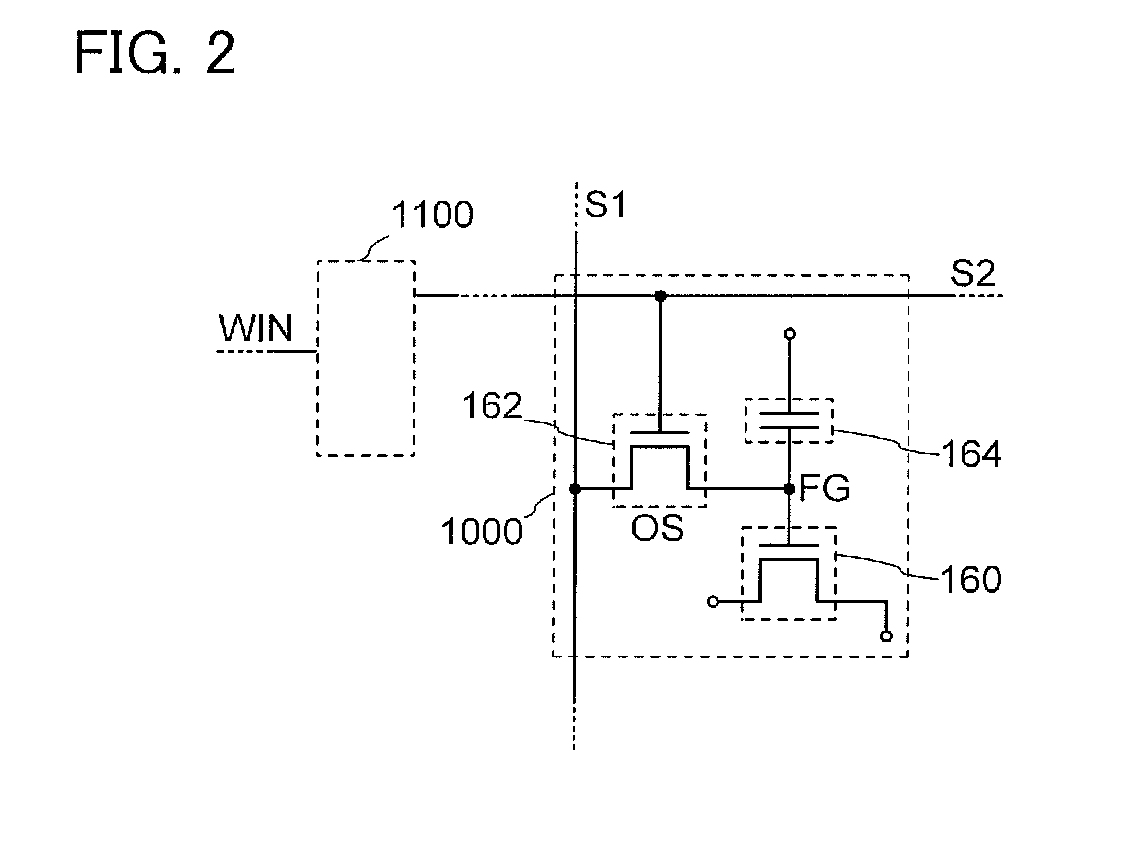Semiconductor device and method for driving the same
a technology of semiconductor devices and semiconductor devices, applied in the direction of digital storage, capacitors, instruments, etc., can solve the problem that the semiconductor device can hold data for a long time, and achieve the effect of further improving the character of the semiconductor devi
- Summary
- Abstract
- Description
- Claims
- Application Information
AI Technical Summary
Benefits of technology
Problems solved by technology
Method used
Image
Examples
embodiment 1
[0060]In this embodiment, a basic circuit structure and operation of a semiconductor device according to one embodiment of the disclosed invention will be described with reference to FIGS. 1A-1, 1A-2, and 1B, FIG. 2, FIG. 3, FIG. 4, FIG. 5, and FIG. 6. Note that in each of the circuit diagrams, “OS” may be written beside a transistor in order to indicate that the transistor includes an oxide semiconductor.
1>
[0061]First, the most basic circuit structure and its operation will be described with reference to FIGS. 1A-1, 1A-2, and 1B. In the semiconductor device in FIG. 1A-1, a first wiring (a 1st line) and a source electrode (or a drain electrode) of a transistor 160 are electrically connected to each other, and a second wiring (a 2nd line) and the drain electrode (or the source electrode) of the transistor 160 are electrically connected to each other. In addition, a third wiring (a 3rd line) and a source electrode (or a drain electrode) of a transistor 162 are electrically connected t...
specific example
[0100]Next, a specific example of the potential converter circuit 1100 and operation of a semiconductor device using that will be described with reference to FIG. 3 and FIG. 4.
[0101]FIG. 3 illustrates an example of the potential converter circuit 1100 and the memory cell 1000. The potential converter circuit 1100 and the memory cell 1000 are connected to each other through the second signal line S2. Here, as a memory cell, the memory cell 1000 in FIG. 2 can be used.
[0102]The potential converter circuit 1100 includes a first wiring BT, a second wiring WIN, a third wiring CTRL, a transistor 201, a transistor 202, and a capacitor 200 (also referred to as a second capacitor).
[0103]Here, the second signal line S2, one electrode of the capacitor 200, and a source electrode (or a drain electrode) of the transistor 202 are electrically connected to one another. The other electrode of the capacitor 200 and a source electrode (or a drain electrode) of the transistor 201 are electrically conne...
embodiment 2
[0126]In this embodiment, a structure and a manufacturing method of a semiconductor device according to one embodiment of the disclosed invention will be described with reference to FIGS. 7A and 7B, FIGS. 8A to 8D, FIGS. 9A to 9C, FIGS. 10A to 10D, and FIGS. 11A to 11C.
[0127]FIGS. 7A and 7B illustrate an example of a structure of a semiconductor device. FIG. 7A illustrates a cross section of the semiconductor device, and FIG. 7B illustrates a plan view of the semiconductor device. Here, FIG. 7A illustrates a cross section taken along lines A1-A2 and B1-B2 in FIG. 7B. The semiconductor device illustrated in FIGS. 7A and 7B includes the transistor 160 including a first semiconductor material in a lower portion, and the transistor 162 including a second semiconductor material in an upper portion. Here, the first semiconductor material and the second semiconductor material are preferably different from each other. For example, the first semiconductor material may be a semiconductor mate...
PUM
 Login to View More
Login to View More Abstract
Description
Claims
Application Information
 Login to View More
Login to View More - R&D
- Intellectual Property
- Life Sciences
- Materials
- Tech Scout
- Unparalleled Data Quality
- Higher Quality Content
- 60% Fewer Hallucinations
Browse by: Latest US Patents, China's latest patents, Technical Efficacy Thesaurus, Application Domain, Technology Topic, Popular Technical Reports.
© 2025 PatSnap. All rights reserved.Legal|Privacy policy|Modern Slavery Act Transparency Statement|Sitemap|About US| Contact US: help@patsnap.com



